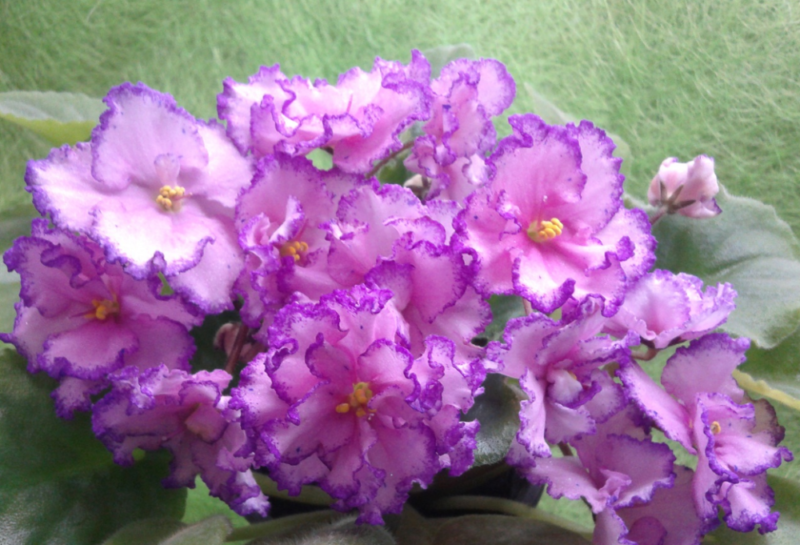Indoor senpolia is a lot of varieties. One of the most beautiful is considered violet "Angelica". She was bred by St. Petersburg breeder Tatyana Pugacheva. A plant with bright pink lush flowers will give your room a romantic look. The variety is popular due to its decorative and unpretentiousness.
Material Content:
Description of the variety of violets "Angelica"
Description of the variety must begin with inflorescences. Terry or semi-double flowers are bright pink with light blue dots. On the edge - corrugated, with a double purple and white border. The color depends on the age of the plant: only during the second and next flowering does a white border appear on the outside of the petals. Young senpolis do not have it.
The first flowering begins 9-11 months after planting. During it, 6-7 buds are revealed on the peduncle. It blooms for a long time.
In summer, the white border is almost invisible, in winter it is clearly visible. Leaves of the usual appearance, smooth, even, double color: shiny above, dark green, saturated red below. This is clearly visible in the photo.
The outlet is large, spreading. The variety is prolific, gives a lot of children.
Growing Features
Violets are light-loving plants. But they do not like direct sunlight, which causes leaf burns. They grow well on the north and north-east windows, bloom a lot and for a long time. When located in other places, flower pots necessarily shade. They do not like drafts. Cold flows contribute to the formation of beige spots on the leaves.
When growing Uzumbar violets, you should know a few secrets:
- to give the sockets the correct shape, the pots must be constantly turned to the light in different directions;
- the lower leaves are carefully cut during flowering.The flower will look more impressive;
- plants grow old quickly - every 2 years their flowers need to be updated, growing new ones that are;
- for brighter tones during flowering, Saintpaulia should be watered with a pink solution of potassium permanganate.
Houseplant Care
To violet "Angelica" grew and bloomed, care must begin with a pot. The size of the container should not be more than 10 cm in diameter. You can use plastic containers.
The plant prefers light and loose soil. You can cook it yourself by typing land in the forest.
Store soil consists of the following components:
- humus;
- soddy soil;
- moss sphagnum;
- sand.
The advantage of the purchased mixture is its sterility.
On a note! The soil mixture must be loose for a good air exchange.
Violets require careful attention when watering. They often die from abundant moisture. Watered with warm melt, settled or rain water. You can pour it into a pallet or under the root, trying not to fall on the leaves. If the drops nevertheless fell on the leaves, they must immediately be collected with a napkin. Otherwise, burns form in wet places. Water is drained from the pan after 20 minutes.
The temperature in the room is maintained at +22 0C. Higher temperature parameters affect the humidity of the air masses: they become drier. Violet "PT-Angelika" does not like this. The buds do not grow well, inflorescences become smaller and quickly fade.
Three months after planting, the senpolia does not need additional nutrition. After that, liquid fertilizers designed for indoor plants are used.
Proper nutrition is as follows:
- two hours before it, flowers are well watered so as not to burn the root system;
- then make liquid fertilizer according to the instructions;
- when the leaves wilt, it should be treated with Epin solution and covered with a regular bag for 3-4 days. You can’t feed.
Breeding methods
At home, the senpolia is propagated by rosettes, peduncles, and most often by lower leaves.
When using leaves, some varieties obtained by the breeding method do not adopt the signs of the mother liquor. In this case, take a socket or peduncle.
You can root the leaf in water and soil. Experienced gardeners argue that using a container with soil is better than a glass of water. The fact is that the roots formed in the water are weak and fragile. During planting in the ground, they break off and the plant is poorly rooted. Seedlings grown using soil are stronger and more durable.
When a rosette appears next to a planted leaf, young violets are transplanted into pots (5-6 cm in diameter). The next time the transplant is carried out after 3-4 months in a container with a diameter of 7-9 cm.
Pest and Disease Control
Senpolia most often suffer from late blight in high humidity. Brown stains appear on the stems and leaves. At the first sign, diseased plants are destroyed, the pots are disinfected to prevent the infection of healthy ones.
Of the pests, a root nematode is known. The phytophage can fall into a pot with ordinary soil. Therefore, it is better to buy soil for planting.
Thrips settle on the underside of the leaf blade. The infected leaves are cut off, and the flower pot is isolated so that these small insects do not move to other planting containers.
















